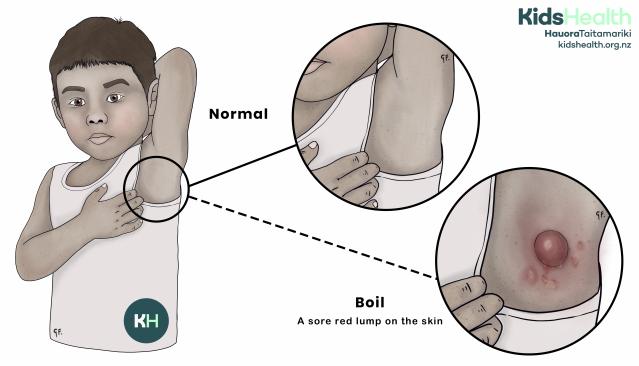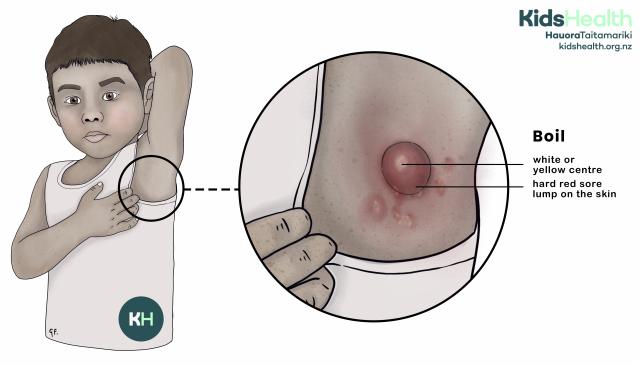Key points about boils
- a boil is a tender red lump on the skin
- a boil is an infection caused by bacteria
- most tamariki (children) with boils are otherwise healthy
- boils are not usually a serious problem
- if your child has a fever, increasing pain or the infection keeps spreading, go to see a health professional
What are boils?
- a boil is a tender, red lump on the skin
- a boil is caused by a bacterial infection (usually Staphylococcus aureus) of the hair root or sweat pore
- boils are not usually a serious problem
- sometimes the boils may spread to other parts of the body
- larger boils may form abscesses

An illustration showing a boil on the skin under a child’s arm.
Source: KidsHealth
transcribeTranscript
The illustration shows a child lifting their arm to reveal the skin under the arm.
- A circular close-up labelled Normal shows healthy skin with no redness or swelling.
- Another circular close-up labelled Boil shows a sore, red, raised lump on the skin, with surrounding redness.
At the bottom of the illustration is the KidsHealth logo with the website: kidshealth.org.nz.
Causes of boils
Anyone can develop a boil.
Some of the following conditions can increase the risk of your child getting boils:
- eczema
- skin with grazes or cuts - these can allow bacteria to enter
- weakened defence system (immune deficiency)
Signs and symptoms of boils
- a hard, red and sore lump on your child’s skin
- increasing size and soreness of the lump
- development of a white or yellow centre in the lump, filled with pus, which can sometimes burst

An illustration showing a boil on the skin under a child’s arm, with labelled features.
Source: KidsHealth
transcribeTranscript
The illustration shows a child lifting their arm to reveal the skin under the arm.
A large circular close-up shows a Boil on the skin. The boil is a raised, red, sore lump with surrounding redness.
Lines point to labelled features:
- white or yellow centre
- hard red sore lump on the skin
At the bottom of the illustration is the KidsHealth logo with the website: kidshealth.org.nz.
When to get medical help for your child's boil
See a health professional urgently if there is a boil or any redness near your child's eye.
See a health professional if:
- your child is complaining of lots of pain or discomfort
- your child develops a fever
- the skin around the boil has redness that is spreading
- the boil keeps getting bigger
- boils keep appearing
- your child has an immune problem
Sometimes, a boil can turn into an abscess. This is a large, deep boil. If you think your child's boil has become an abscess, take them to see a health professional. This may need hospital treatment.
Caring for your child with a boil at home
You can treat most boils at home, especially if you notice them early.
Use a warm facecloth
To help the boil open up and drain, try using a warm facecloth. Put it on the boil for several minutes. Do this a few times a day. Always wash your hands before and after touching the boil.
Practise good hygiene
Boils can spread very easily. If the boil opens on its own and drains, wipe away the pus or blood with a clean cloth. Wash and dry the area well and then cover it with a plaster. This stops it from spreading and stops your child from scratching it. Wash and dry your hands before and after touching the boil.
Wash your child all over with warm soapy water or use an antiseptic solution such as Savlon or Dettol. Follow the directions on the bottle for making the solution. Use a separate towel and facecloth for your child. Wash used towels often, in hot water, along with clothing worn close to the skin.
Don't squeeze the boil
Squeezing the boil into the surrounding skin can cause a more serious infection and will be painful.
Keep an eye on the boil
If other boils appear or the boil gets bigger or more painful, take your child to a health professional.
Give pain relief if necessary
Most tamariki will not need any medicine.
Give your child paracetamol, if needed, to help with the soreness. You must follow the dosage instructions on the bottle. It is dangerous to give more than the recommended dose.
Management of boils
Antibiotics
Your health professional may prescribe antibiotic medicine. If your child needs to take antibiotics, follow the instructions and take them until they are finished. Do not stop the antibiotics early.
Surgery
If your child's boil has become an abscess, they may need an operation.
During the operation
Your child will need a general anaesthetic because it is painful.
The surgeon will cut (incise) the abscess, remove the pus and put a sterile dressing over the cut to absorb any draining pus.
Your child may need antibiotics through an intravenous drip (into a vein).
After the operation
Your child will not usually need to stay in hospital.
If your child has a dressing, the healthcare team at the hospital will give you instructions about what to do. It's important not to get the dressing wet.
Recurrent boils
Sometimes tamariki can suffer from recurrent boils, which can spread to other household members. This is usually because a child carries a strain of bacteria that can easily cause infection of any broken skin (minor cuts and scrapes). It's important to treat all household members with skin infections to stop the infection spreading.
Your doctor may take a swab of the boil to see what treatment is best.
Treatments to get rid of bacteria on the skin
This may include strategies like:
- having dilute bleach baths twice a week
- washing all your child's towels and bedding in hot water
- using an antiseptic wash in the shower when your child has cuts or scrapes
Antiseptic baths 2 times a week can help prevent infection and improve eczema.
Your doctor may also suggest:
- using a different antibiotic for a longer course
- using an antiseptic wash for a week
- putting an antibiotic cream in the nostrils (where the bacteria often live)
Acknowledgements
Illustrations by Dr Greta File. Property of KidsHealth.
